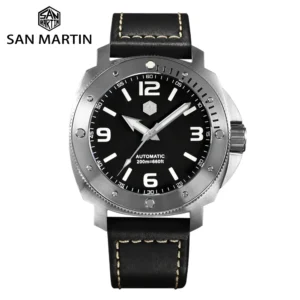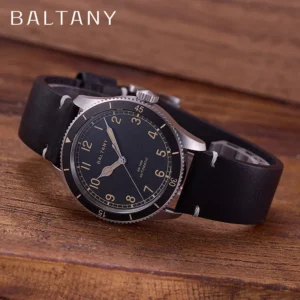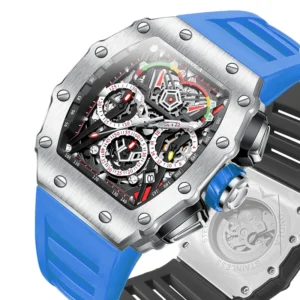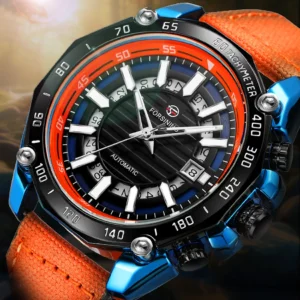Introduction: The Quintessential Tool Watch Defined
The field watch stands as perhaps the most honest expression of timekeeping engineering – a watch stripped to its essential purpose and built to perform reliably under the most challenging conditions. Unlike their more decorative counterparts, these timepieces embody the philosophy that true design excellence emerges from uncompromising functionality.
Field watches are characterized by several distinctive features:
– High contrast dials with bold Arabic numerals for instant legibility
– Durable cases built to withstand impact and environmental stress
– Luminous hands and markers for visibility in low-light conditions
– Straightforward time-telling functionality without unnecessary complications
– Reliable movements prioritizing accuracy and dependability over decoration
These timepieces represent more than mere tools; they embody a design philosophy that has remained remarkably consistent despite technological advancement. The history of the field watch traces a fascinating journey from battlefield necessity to versatile everyday companion, while maintaining its commitment to clarity, durability, and function.
The evolution of military field watches follows a path marked by practical innovation rather than fashion, with each refinement serving a specific purpose. Today’s enthusiasts seeking these purposeful timepieces often explore collections of automatic field and military watches that honor this heritage while incorporating modern advancements.
From Pocket to Wrist: Early Precursors and Trench Watches
The transition from pocket watches to wristwatches represents one of the most significant evolutionary leaps in horological history, driven not by fashion but by practical battlefield necessity. Early military operations revealed the critical limitations of pocket watches: they required two hands to operate, were easily damaged when dropped, and proved cumbersome during combat maneuvers.
The earliest wristwatch adaptations were essentially pocket watch movements retrofitted with wire lugs soldered onto the cases. These “wristlets” or “trench watches” marked the beginning of a significant design shift driven by the practical demands of warfare.
Key innovations of these early trench watches included:
– Wire lugs soldered to cases allowing attachment of canvas or leather straps
– Protective metal “shrapnel guards” or grilles to prevent glass breakage
– Early luminous compounds on dials and hands (often radium-based)
– Improved water resistance attempts with screw-down bezels or cases
– Oversized crowns designed for ease of manipulation while wearing gloves
These pioneering designs emerged from urgent battlefield requirements rather than fashion considerations. The harsh realities of combat demanded timepieces that could withstand moisture, shock, and extreme temperatures while remaining easily readable under chaotic conditions.
The evolution from trench to field watches represents a fascinating chapter in horological development, showing how warfare necessitated innovations that would eventually influence civilian timepiece design for generations to come.
The Birth of Military Specifications and Standardization
As militaries recognized the strategic importance of reliable timekeeping, they began developing formalized standards for wristwatches issued to personnel. This transition from improvised solutions to standardized equipment marked a turning point in field watch development.
Military specifications transformed watches from personal accessories to precision instruments with standardized requirements:
- Case construction: Transition from plated brass to corrosion-resistant stainless steel
- Dial specifications: High-contrast black dials with white Arabic numerals and minimal decorative elements
- Crystal requirements: Shatter-resistant materials with specific thickness parameters
- Movement standards: Minimum jewel counts, shock protection, and timing accuracy tolerances
- Water resistance: Specific depth ratings to ensure reliability in various field conditions
- Strap attachments: Fixed bars or spring bars meeting specific pull-strength requirements
These standards prioritized absolute functionality over aesthetics, embodying the “tool watch” philosophy where every design element served a practical purpose. Sub-seconds dials became standard features, allowing precise timing operations and serving as visual confirmation that the watch was running properly.
The military necessity that forged the modern field watch created timepieces that were genuinely mission-critical equipment rather than accessories. This heritage continues to influence classic field watches that maintain these functional design principles while incorporating contemporary advancements.
The A-11: The Archetypal Field Watch
No single timepiece has had a more profound influence on field watch design than the A-11 specification. This military-issued watch represents the platonic ideal of what a field watch should be – legible, durable, and reliable under extreme conditions. The A-11 established the template that continues to define field watches to this day.
The A-11 specification introduced several revolutionary features:
- Hacking seconds function that allowed precise synchronization between multiple watches
- Black dial with white Arabic numerals providing maximum readability in varied light conditions
- Central seconds hand for precise timing operations
- High-jewel (15+ jewels) manual wind movements for enhanced reliability
- Dust and moisture-resistant case construction
- Unpolished case finish to prevent reflections that might reveal a soldier’s position
- Secure fixed lugs that eliminated the failure point of spring bars
The hacking seconds feature proved particularly crucial for military operations. By allowing the second hand to stop when the crown was pulled out, soldiers could synchronize their watches to the second – a capability essential for coordinated maneuvers and artillery timing.
Multiple manufacturers produced watches to the A-11 specification, maintaining consistent functionality while allowing for minor variations in execution. This standardization ensured that replacement watches would function identically regardless of manufacturer.
The evolution of army-issued timepieces shows how the A-11 design principles established enduring standards that would influence military and civilian watches for generations to come.
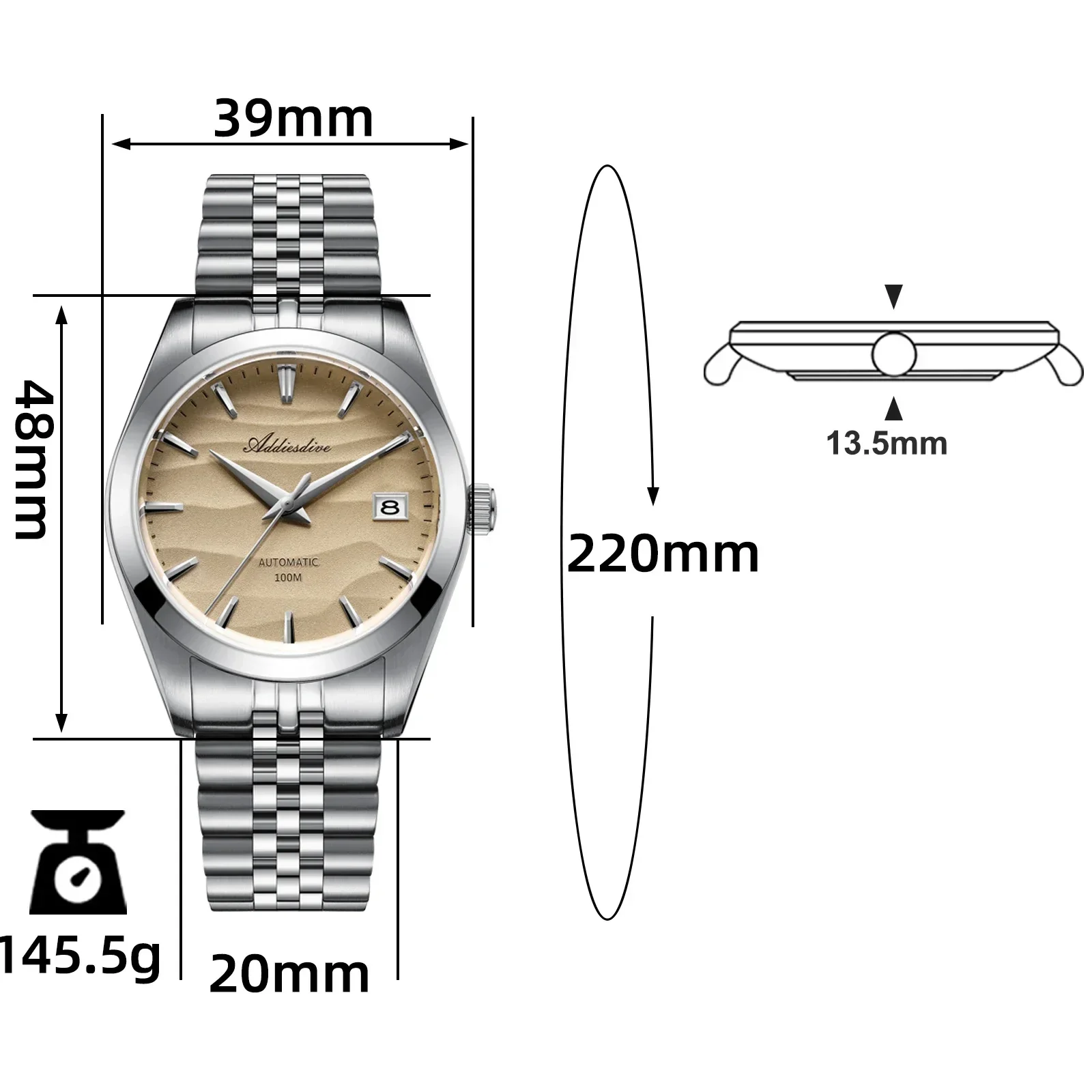
The British “Dirty Dozen”: Alternative Approaches to Field Watch Design
While the A-11 specification defined field watch development in America, the British W.W.W. (Watches, Wristlet, Waterproof) program produced its own distinct approach to military timekeeping. Commonly known as the “Dirty Dozen” due to the twelve manufacturers commissioned to produce them, these watches demonstrate how different military requirements led to parallel evolutionary paths.
Comparison of Key Features:
| Feature | A-11 Specification | W.W.W. “Dirty Dozen” |
|---|---|---|
| Seconds Display | Center seconds | Sub-seconds at 6 o’clock |
| Dial Marking | Minimalist with luminous indices | Railroad track minute markers with lume |
| Military Marking | Case backs only | Broad arrow on dial |
| Case Design | Mid-sized with straight lugs | Larger diameter with more pronounced lugs |
| Crown Guards | None | Some models with rudimentary protection |
| Movement | High-jewel, manually wound | Manually wound with enhanced shock protection |
The British approach emphasized slightly different priorities, including the distinctive railroad track minute markers that enhanced precise reading of time. The sub-seconds dial at 6 o’clock represented a more traditional approach compared to the central seconds of the A-11.
Perhaps most distinctively, the British W.W.W. watches featured the broad arrow marking on the dial – a centuries-old symbol denoting British government property. This visible military provenance contrasted with the more understated American approach.
Despite these differences, both designs adhered to the core field watch principles of legibility, durability, and reliability. Today’s military-inspired automatic watches often draw inspiration from both traditions, combining elements from these parallel evolutionary paths.
Post-War Evolution: Technical Advancements and Civilian Adoption
Following major conflicts, field watches underwent significant technical refinements while simultaneously transitioning into civilian markets. Military surplus watches became available to the public, introducing everyday users to the practical benefits of field watch design.
Technical improvements expanded the capabilities of field watches:
– Enhanced water resistance through improved gasket materials and case engineering
– Advanced shock protection systems like Incabloc and Diashock to safeguard delicate movement components
– Transition from radium to safer tritium and eventually Super-LumiNova for luminous elements
– Introduction of automatic self-winding movements eliminating the need for daily winding
– Improved crystal materials offering better scratch and impact resistance
The civilian adoption of field watches accelerated as manufacturers recognized the commercial potential of these rugged timepieces. Brands began producing non-military versions that maintained the core design elements while introducing variations in colors, materials, and finishing.
Perhaps no accessory exemplifies the post-war evolution better than the introduction of the G10 strap – now commonly known as the “NATO” strap. Originally developed for British military use, these nylon straps offered several practical advantages:
– The pass-through design ensured the watch remained secured even if a spring bar failed
– Quick-drying nylon proved ideal for wet conditions
– The material was non-reflective and silent during operations
– Inexpensive and easily replaceable in field conditions
The field watch functionality in combat zones established design principles that proved equally valuable for civilian outdoor enthusiasts, tradespeople, and anyone requiring a reliable timepiece in challenging conditions.
The Quartz Revolution: Pragmatic Shift in Military Timekeeping
The introduction of quartz movement technology in the late 20th century fundamentally transformed military timekeeping priorities. Mechanical watches, despite their heritage and charm, were suddenly outclassed in terms of raw accuracy and maintenance requirements.
Quartz technology offered compelling advantages for military applications:
– Superior accuracy of ±15 seconds per month compared to ±15 seconds per day for mechanical watches
– Dramatically reduced maintenance needs with no regular winding or service requirements
– Lower production costs allowing more widespread distribution
– Extended service intervals reducing logistical burdens
– Greater shock resistance with fewer moving parts
Military procurement shifted toward these more practical quartz solutions, which delivered superior performance at lower costs. This transition prompted a temporary decline in mechanical field watches for active service, though their design language remained influential.
Interestingly, while the movement technology changed dramatically, the external design elements of field watches remained remarkably consistent. The same high-contrast dials, luminous markings, and durable cases continued to define the category. This continuity demonstrates how the core principles of field watch design transcend specific technologies.
The proven track record of rugged watches in extreme conditions meant that even as internal mechanisms evolved, the time-tested external design elements remained largely unchanged, proving their enduring functionality.
Materials Revolution: From Steel to Advanced Composites
The evolution of materials technology has dramatically expanded the performance capabilities of field watches while maintaining their core design principles. Each material advancement has addressed specific operational challenges, from corrosion resistance to weight reduction.
Case Materials Evolution:
| Material | Advantages | Considerations |
|---|---|---|
| Brass (Early) | Inexpensive, easy to machine | Susceptible to corrosion, requires plating |
| Stainless Steel | Excellent corrosion resistance, durability | Relatively heavy, can be reflective |
| Titanium | Lightweight (40% lighter than steel), hypoallergenic | More expensive, shows scratches more readily |
| Ceramic | Extremely scratch-resistant, lightweight | Potentially brittle, limited color options |
| Carbon Composites | Ultra-lightweight, high strength-to-weight ratio | Expensive, less traditional aesthetic |
| PVD-Coated Steel | Enhanced hardness, varied color options | Coating can wear at edges over time |
Crystal materials have similarly evolved from easily scratched acrylic to virtually unscratchable sapphire with anti-reflective coatings. This progression has enhanced both durability and readability in varying light conditions.
Strap technology has advanced significantly from canvas and leather to include:
– Heat-resistant and quick-drying synthetic fabrics
– Specialized rubber compounds maintaining flexibility in extreme temperatures
– Titanium and lightweight alloy bracelets with micro-adjustment capabilities
– Composite materials combining flexibility with extreme durability
These material innovations have allowed field watches to become lighter, stronger, and more resistant to environmental extremes without compromising their essential design language. The rugged automatic watches available today benefit from these advancements while maintaining the purposeful aesthetic that defines the category.

Modern Field Watches: Heritage Meets Contemporary Technology
Today’s field watches represent a fascinating balance between honoring historical design codes and incorporating modern horological advancements. The best examples maintain the unmistakable DNA of their military forebears while offering performance capabilities that far exceed their ancestors.
Contemporary field watches preserve these heritage design elements:
– High-contrast dials prioritizing legibility above all else
– Arabic numerals marking each hour position
– Distinctive triangle or arrow marker at 12 o’clock for orientation
– Sword, pencil, or syringe-style hands with generous luminous material
– 24-hour scales for military time reference
– Uncluttered dial layouts focusing on essential information
Simultaneously, modern technology has enhanced every aspect of performance:
– Extended power reserves of 70+ hours compared to the typical 36-40 hours of vintage models
– Enhanced magnetic resistance (up to 15,000 gauss) protecting against modern electronic fields
– Super-LumiNova and similar compounds providing brighter, longer-lasting illumination without radioactivity
– Improved water resistance with 100m+ ratings becoming standard
– Advanced manufacturing tolerances delivering greater accuracy and reliability
– Specialized variants for extreme environments like arctic exploration or high-altitude operations
The field watch has proven remarkably adaptable to technological progress without losing its essential character. The core principles of legibility, durability, and reliability remain paramount, even as the specific mechanisms for achieving those goals have evolved.
The timeline of tactical field watch innovation shows a consistent pattern of thoughtful evolution rather than revolution, with each advancement carefully integrated without compromising the field watch’s fundamental identity. This philosophy is evident in contemporary tactical automatic watches that combine traditional design cues with modern engineering.
Military Inspired Automatic Watches, Rugged Automatic Watches, Tactical Automatic Watches
Price range: $852.14 through $994.60 Select options This product has multiple variants. The options may be chosen on the product pageBronze Automatic Watches, Military Inspired Automatic Watches, Professional Spec Dive Watches
Price range: $1,442.21 through $1,442.82 Select options This product has multiple variants. The options may be chosen on the product pageClassic Pilot Watches, Military Inspired Automatic Watches
$561.00 Select options This product has multiple variants. The options may be chosen on the product pageRugged Automatic Watches, Unique Automatic Watches
Price range: $228.96 through $231.10 Select options This product has multiple variants. The options may be chosen on the product pageClassic Field Watches, Military Inspired Automatic Watches
Price range: $280.87 through $338.51 Select options This product has multiple variants. The options may be chosen on the product pageAutomatic Skeleton Watches, Military Inspired Automatic Watches, Unique Automatic Watches
$191.88 Select options This product has multiple variants. The options may be chosen on the product page
Design Principles: Why Field Watch Aesthetics Endure
The enduring appeal of field watch design extends beyond mere nostalgia or military association. These timepieces represent a masterclass in functional design principles that transcend trends and fashion cycles.
The field watch aesthetic endures because it embodies several timeless design virtues:
First and foremost is the principle of absolute legibility. The high-contrast dial, distinct numerals, and clearly differentiated hands ensure that time can be read instantaneously in virtually any condition. This clarity of purpose creates an inherently balanced visual composition.
Proportional harmony also plays a crucial role. Field watches typically maintain ideal proportions between dial size, bezel width, and case thickness. This balanced relationship creates a visually pleasing whole that sits comfortably on most wrist sizes.
Perhaps most importantly, field watches demonstrate the beauty of restraint. By eliminating unnecessary decorative elements, they achieve a kind of visual purity that more elaborate designs often lack. The absence of superfluous details creates a focused aesthetic where every element serves a purpose.
This dedication to functional minimalism has influenced countless other watch categories and even broader industrial design principles. The field watch demonstrates how design driven by pure functionality can achieve a timeless elegance that transcends changing fashion trends.
The field watch’s enduring appeal also stems from its remarkable versatility. The same watch can appear appropriate with business attire, casual wear, or outdoor equipment – a versatility few other watch styles can match. This adaptability helps explain why the history of professional diving watches shows clear influence from field watch design principles.
Collecting Field Watches: Understanding Heritage and Value
For watch enthusiasts interested in field watches, understanding their historical context and design principles helps identify timepieces that truly capture the essence of this category. Quality field watches, whether vintage or modern, share certain defining characteristics worth recognizing.
Key considerations for collectors include:
– Authenticity of design: True field watches prioritize legibility and functionality over decorative elements
– Case construction: Solid construction with appropriate water resistance and durability features
– Movement quality: Reliable, accurate movements with appropriate shock protection
– Design coherence: All elements working together without unnecessary complications
– Material selection: Appropriate choices that enhance durability and functionality
– Historical faithfulness: How accurately modern pieces interpret traditional design codes
What makes certain field watches particularly collectible often extends beyond brand prestige. The most sought-after pieces typically demonstrate:
– Design purity that perfectly embodies field watch principles
– Technical excellence in movement engineering and case construction
– Thoughtful integration of heritage elements with modern capabilities
– Exceptional craftsmanship in finishing and assembly
– Material quality that enhances both durability and aesthetic appeal
For collectors, field watches offer an accessible entry point to mechanical watch appreciation, with many excellent examples available at moderate price points. Their straightforward design allows new enthusiasts to understand and appreciate fundamental watchmaking qualities without the complexity of more elaborate complications.
The performance of automatic watches in military service established standards that continue to influence both collectors’ expectations and manufacturers’ approaches to modern interpretations.
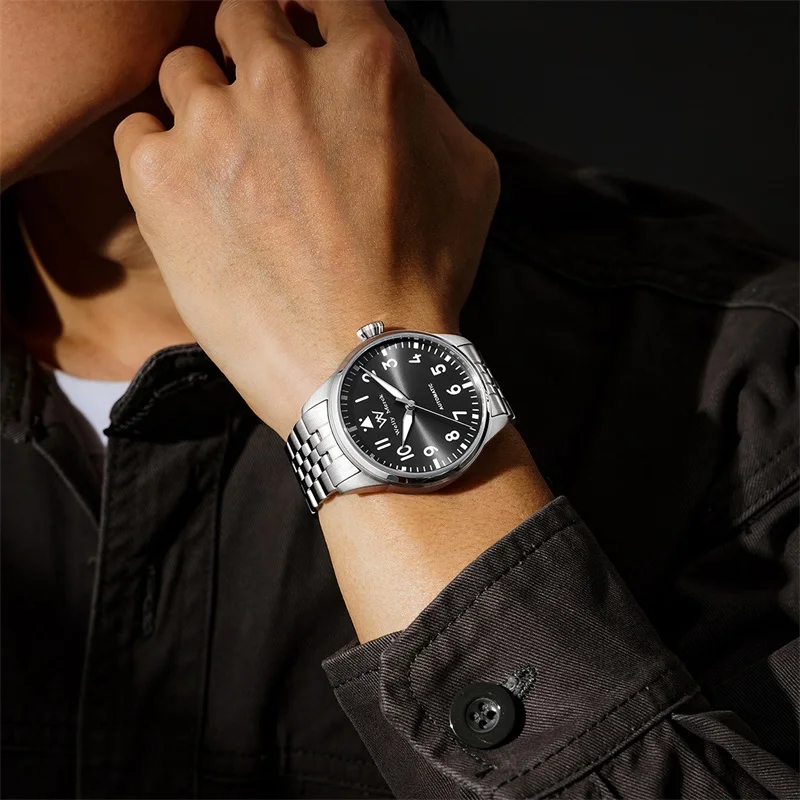
Are Field Watches Still Relevant in the Digital Age?
In an era dominated by smartphones and smartwatches with GPS synchronization and multiple connectivity features, mechanical field watches might seem like anachronisms. Yet their continued popularity suggests they offer enduring benefits beyond mere timekeeping.
Q: With smartphones and smartwatches everywhere, why would anyone need a traditional field watch?
While digital devices offer more features, mechanical field watches provide distinct advantages in certain scenarios. They operate without batteries or charging, functioning reliably for years with basic maintenance. This independence from power sources becomes invaluable during extended outdoor activities, emergencies, or in remote locations.
Q: What practical benefits do field watches offer compared to digital alternatives?
Traditional field watches excel in extreme environments where electronic devices might fail. They remain functional in temperature extremes, can withstand significant electromagnetic interference, and continue operating after impacts that might shatter digital screens. Their simplicity also means fewer potential failure points.
Q: Is there a psychological aspect to wearing a field watch versus using digital timekeeping?
Many users report that analog timekeeping provides a different relationship with time – offering a visual representation that digital displays lack. The glance-and-go nature of a field watch creates minimal distraction compared to screens that might display notifications and other attention-grabbing information.
Field watches also create a deliberate separation from constant connectivity, allowing wearers to remain aware of time without being tethered to communication channels – a balance many find valuable during outdoor pursuits or focused activities.
Rather than competing with digital technology, field watches complement it – offering reliability, simplicity, and independence from power sources when those qualities matter most.
How to Choose Your Ideal Field Watch
Selecting the perfect field watch involves matching specific features to your intended use while considering personal preferences. The following guidelines can help navigate the many options available.
When choosing a field watch, consider these key factors:
Movement type: Mechanical movements offer traditional charm and independence from batteries but require occasional winding (manual) or regular wear (automatic). Quartz provides superior accuracy and carefree operation but depends on battery changes.
Case size: Field watches traditionally range from 36mm to 42mm in diameter. Smaller wrists generally pair well with 36-38mm cases, while larger wrists can accommodate 40-42mm cases comfortably.
Material selection: Stainless steel offers excellent durability and value. Titanium provides similar strength at reduced weight, ideal for active use. Bronze develops a unique patina over time for those preferring a distinctive vintage appearance.
Water resistance: For general everyday wear, 50-100m water resistance suffices. For regular outdoor activities involving water, consider 100-200m ratings. True amphibious use demands 200m+ specifications.
Crystal options: Sapphire crystal provides superior scratch resistance but at higher cost. Mineral crystal offers a good balance between durability and value. Acrylic is historically accurate for vintage-inspired pieces but scratches more easily.
For long-term satisfaction, consider investing in the highest quality you can reasonably afford, as field watches typically serve as long-term companions rather than seasonal accessories. Quality movements, solid case construction, and thoughtful design details reward their owners with decades of reliable service.
Versatility can be extended through strap options – a single quality field watch can take on different characters with canvas, leather, rubber, or metal bracelet options, making it adaptable to various activities and settings.


